
Bitcoin Payments: Eleven-Year Data Overview (2014–2025)
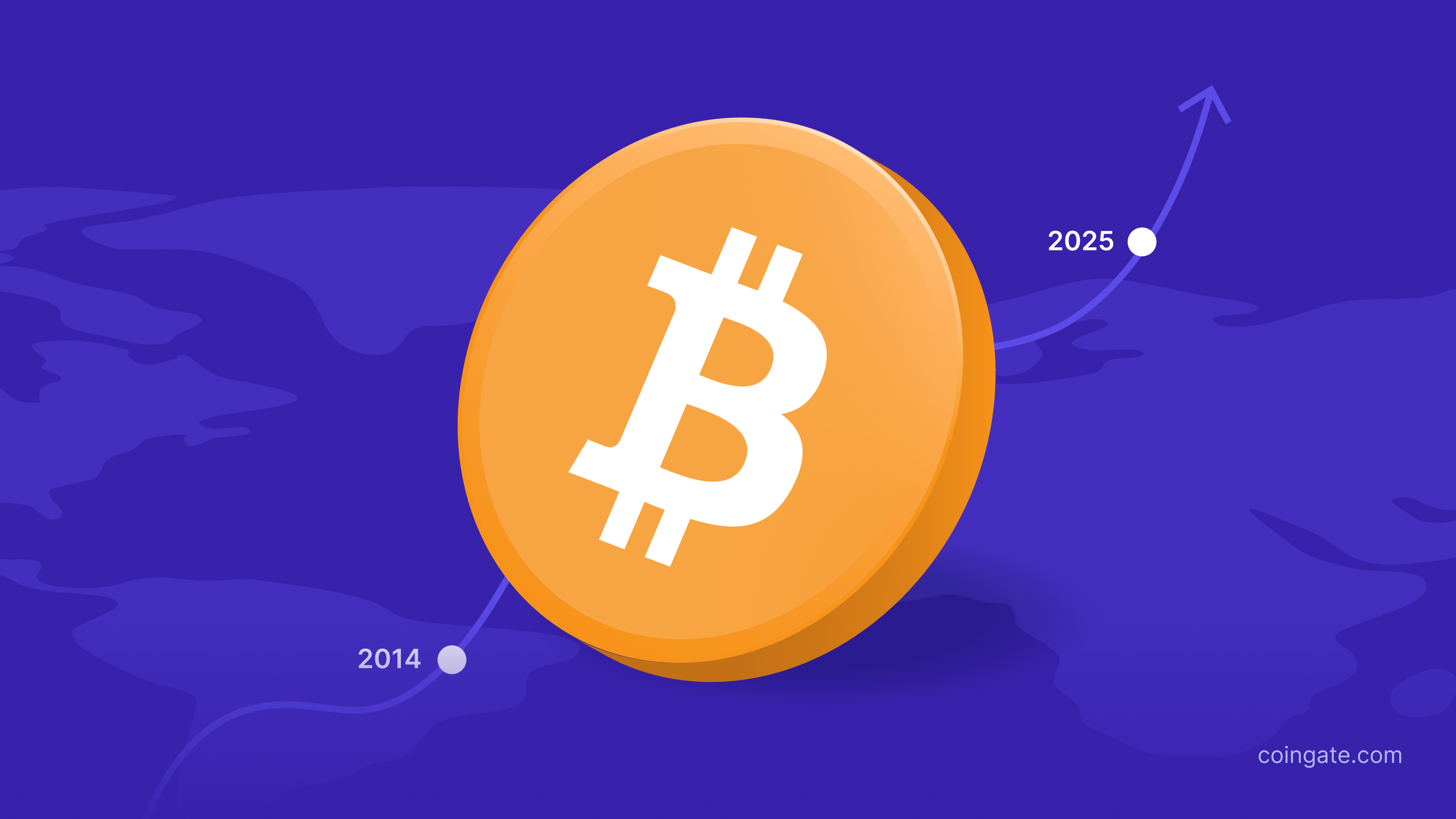
Executive Summary
Bitcoin has been at the core of CoinGate’s payment ecosystem since the very beginning. Integrated in 2014 as our first supported currency, it powered every crypto payment on our platform for four years before others joined. Eleven years later, Bitcoin remains the benchmark for crypto payments, accounting for 44% of all transactions processed on CoinGate between 2014 and 2025.
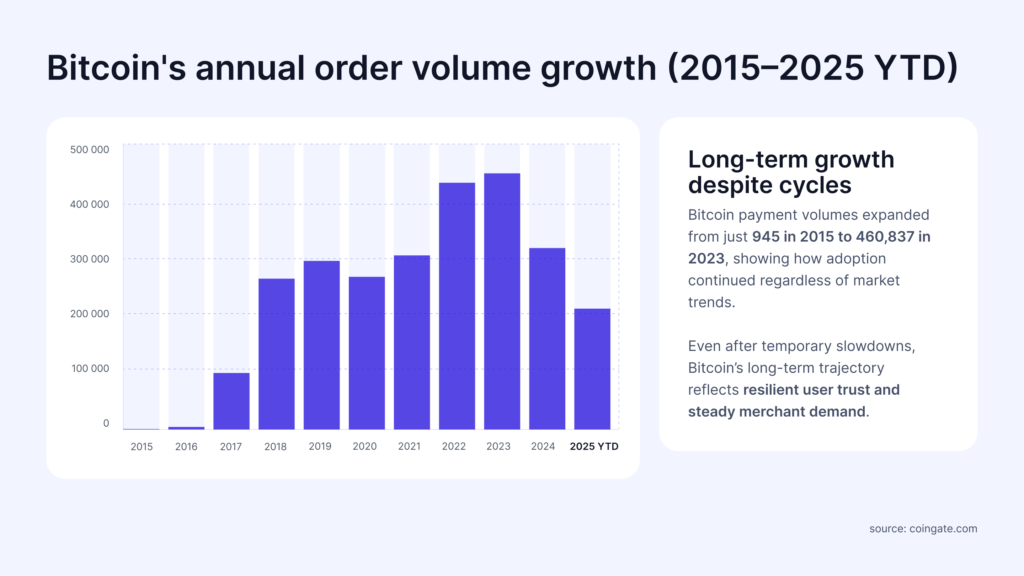
Industry forecasts align with Bitcoin’s long-term relevance – the Bitcoin payment ecosystem reached an estimated $1.32 billion in 2024 and is expected to grow to $2.75 billion by 2029 (15.4% CAGR), which underscores sustained demand for BTC in global commerce, as The Business Research Company reports.
Even as new assets entered the mix, Bitcoin’s dominance never truly faded. It has consistently ranked as the most used payment method, holding the #1 position every year except 2024, when USDT briefly took the lead. In 2025, Bitcoin reclaimed its crown as the most popular currency on CoinGate – responsible for 22.7% of all payments so far this year, followed by USDT (19.8%), LTC (14%), and USDC (11.5%).
The data shows Bitcoin’s remarkable adaptability. In 2022, transaction volumes grew by 41.7% year-over-year despite a bear market, proving that Bitcoin’s utility in commerce doesn’t rely solely on price cycles. By 2024, stablecoins began capturing share, but in 2025, Bitcoin regained momentum as regulatory implications impacted USDT usage, allowing BTC to once again dominate checkouts.
Bitcoin shoppers span the globe. The United States (40.3%) leads by a wide margin, followed by Germany (6.3%), the United Kingdom (5.8%), the Netherlands (5.2%), and Canada (4%). This geographic mix shows that Bitcoin payments are still concentrated in mature markets like the U.S. and Western Europe, leaving considerable room for growth in emerging regions where access to traditional payment systems remains limited.
Feels like it’s time to introduce cryptocurrency payments to your checkout? Sign up for CoinGate.
Average cart sizes confirm that versatility. In 2025, the average Bitcoin order is worth €132, significantly higher than the platform average. This year’s purchases range from €0.18 proxy orders to €100,000 private jet services, showcasing Bitcoin’s range across both micro and high-end transactions.
Bitcoin’s strongest merchant verticals include web hosting (35.3%), consumer goods (11%), VPNs (7.4%), proxies (6.9%), and IT services (6.1%) – reflecting steady use in digital-first industries. Among the top merchants are Hostinger (15%), NordVPN (5.1%), and Eldorado.gg (3.4%), proving that Bitcoin remains a preferred option for mainstream online services as well as niche use cases.
On the merchant side, behavior shows a growing shift toward long-term confidence. In 2025, 25.9% of Bitcoin payments were kept in BTC rather than converted to something else after payment has been received – the highest share recorded between 2022 and 2025. The rest were mostly settled in EUR (52.9%), USDC (12.9%), and USD (4.2%). As the share of EUR settlements declines over time, more merchants are choosing to retain Bitcoin or diversify into crypto assets for their treasuries.
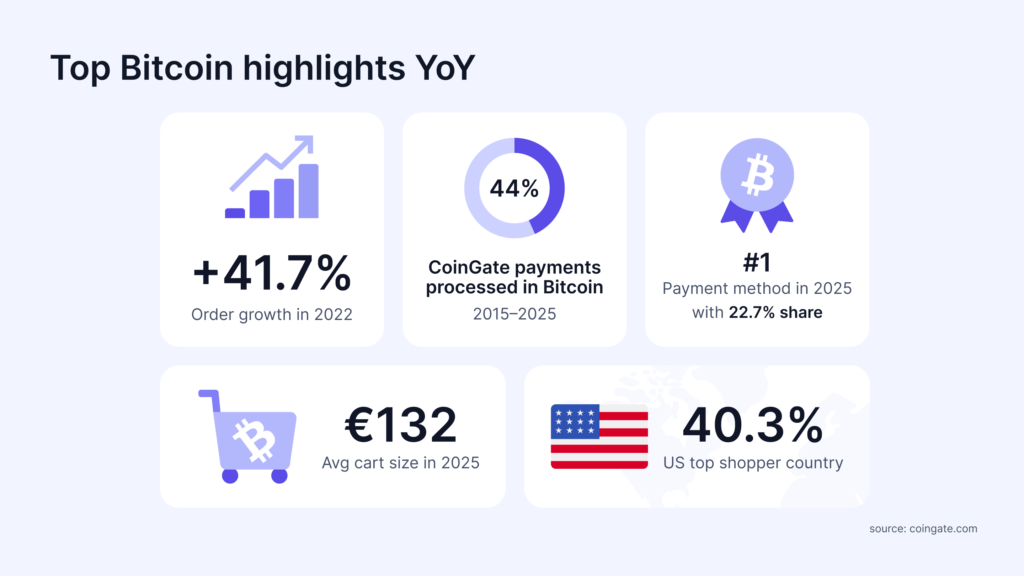
Since 2018, CoinGate has also supported the Bitcoin Lightning Network, among the earliest payment processors to do so. Between 2018 and 2025, 6% of all Bitcoin orders have been made through Lightning, peaking in 2024 (15.4%) before declining to 11.7% in 2025. Lightning continues to expand Bitcoin’s utility by making small, fast, and low-fee payments practical for global merchants.
Taken together, the data tells us that Bitcoin remains the foundation of the crypto payments economy. Its dominance might fluctuate, but its relevance doesn’t. Across market cycles, regulatory shifts, and thousands of merchants, Bitcoin continues to stand as the most trusted, most transacted, and most enduring payment currency on CoinGate.
Key Highlights:
- 44% of all CoinGate payments (2015–2025) were made in Bitcoin – the clear long-term leader.
- +41.7% order growth in 2022, despite the bear market.
- #1 payment method in 2025 with 22.7% share (followed by USDT 19.8%, LTC 14%, USDC 11.5%).
- Top shopper countries: US (40.3%), Germany (6.3%), UK (5.8%), Netherlands (5.2%), Canada (4%).
- Average cart size €132 in 2025 – among the highest across all cryptocurrencies.
- Top industries: Web hosting (35.3%), Consumer goods (11%), VPNs (7.4%), Proxies (6.9%), IT services (6.1%).
- 25.9% of collected BTC were not exchanged to other currencies in 2025 – highest since 2022.
Methodology & Definitions
This report is based on CoinGate’s internal payment data covering the period from 2014 through September 2025. Bitcoin was the first cryptocurrency supported on CoinGate and remained the only one available until 2018, which gives us over a decade of perspective on how Bitcoin usage evolved from a single-currency ecosystem to a multi-asset payment environment.
To ensure consistency, the following definitions are used throughout the report:
- Processed orders – successfully completed customer payments in Bitcoin on CoinGate.
- Payment share – the percentage of total crypto payments made in Bitcoin within a given timeframe.
- Average cart size – the average euro value of individual Bitcoin transactions, converted at the moment of payment.
- Settlements – how merchants handled the received Bitcoin after payment (kept, converted to fiat, or converted to another crypto asset).
- Payouts (SEND transactions) – funds sent from CoinGate merchant balances, whether kept in BTC or converted prior to payout.
- Lightning Network payments – Bitcoin payments processed via the Lightning Network since its integration in 2018.
Several contextual factors influenced Bitcoin payment volumes and market share over the years:
- Integration milestones: the addition of Litecoin, Ethereum, and other coins in 2018 changed the competitive landscape.
- Market conditions: price cycles and volatility affected how both merchants and consumers used Bitcoin for transactions.
- Stablecoin expansion: the rise of USDT and USDC between 2022–2024 temporarily shifted payment preferences.
- Regulatory implications: in 2025, restrictions on USDT due to MiCA helped Bitcoin reclaim the #1 position.
All figures represent real processed transaction data aggregated across thousands of CoinGate merchants worldwide. Minor variations due to rounding and exchange-rate fluctuations are possible.
Bitcoin’s Journey on CoinGate (2014–2025)
Early Years: Building the Foundation (2014–2017)
Bitcoin marked the beginning of CoinGate’s story. When we launched in 2014, it was the only supported cryptocurrency on our platform – the sole option for merchants exploring digital payments.
In those early years, Bitcoin laid the groundwork for everything that came after: the infrastructure, the merchant integrations, and the trust that helped prove crypto payments could work in real commerce.
Between 2014 and 2017, Bitcoin processed 100% of all CoinGate transactions, shaping the baseline for our multi-asset ecosystem that emerged later. This period was defined by experimentation and growth – small businesses, early adopters, and tech-savvy users testing what it meant to pay and get paid in Bitcoin.
Expansion and Diversification (2018–2021)
In 2018, CoinGate expanded beyond Bitcoin for the first time, integrating Litecoin, Ethereum, and Bitcoin Cash. Despite this diversification, Bitcoin’s dominance remained strong, continuing to drive the majority of all payments on the platform.
That same year, we also integrated the Bitcoin Lightning Network, becoming one of the first crypto payment processors to support instant, low-fee Bitcoin transactions. This innovation marked the start of a new era for Bitcoin payments – one where scalability and speed improved dramatically.
Throughout this period, Bitcoin maintained its leadership, even as new assets entered the market. Between 2018 and 2021, BTC’s payment share stayed well ahead of all competitors, proving that for most shoppers and merchants, Bitcoin was still the first choice for crypto transactions.
Growth Through Uncertainty (2022–2023)
In 2022, Bitcoin demonstrated its resilience once again. Despite a global bear market, BTC payment volume on CoinGate grew by 41.7% compared to 2021 – the strongest year of growth in its post-2017 history. This expansion highlighted Bitcoin’s evolving role as a reliable medium of exchange for both everyday shoppers and global merchants.
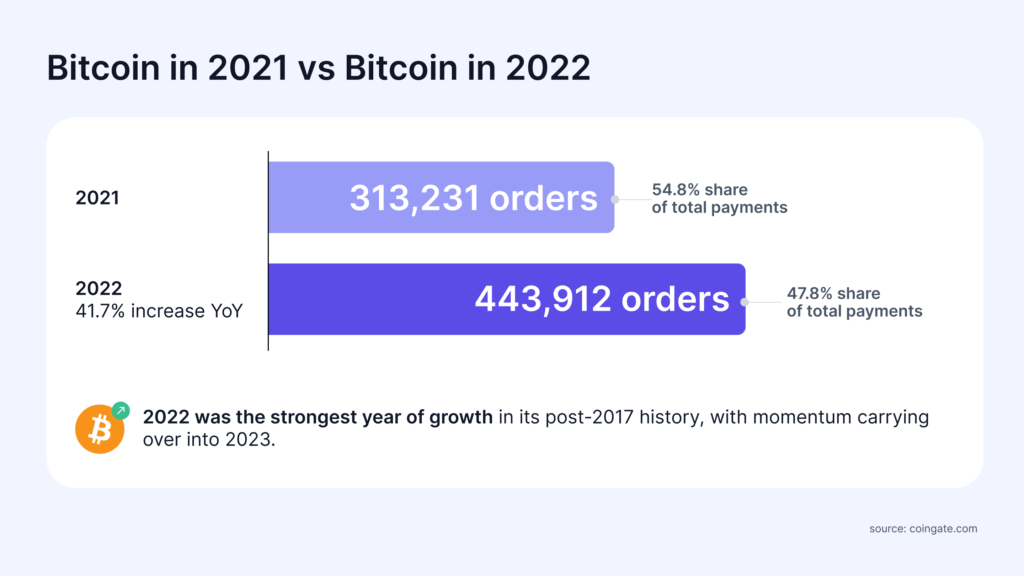
The momentum carried into 2023, as transaction counts and payment share remained high. Even with market corrections and increasing competition from stablecoins, Bitcoin continued to dominate crypto payments on CoinGate, supported by strong consumer trust and the long-standing merchant network built around it.
Competition and Recovery (2024–2025)
The dynamics shifted in 2024, when stablecoins – especially USDT – temporarily overtook Bitcoin as the most popular payment method on CoinGate. BTC’s share of total orders dropped by 16%, reflecting the broader market’s move toward stable-value assets during uncertain periods.
However, in 2025, Bitcoin’s position changed once again. Starting in April 2025, Bitcoin reclaimed the #1 spot as the most used currency for payments, following a decline in USDT usage caused by regulatory implications in the EU.
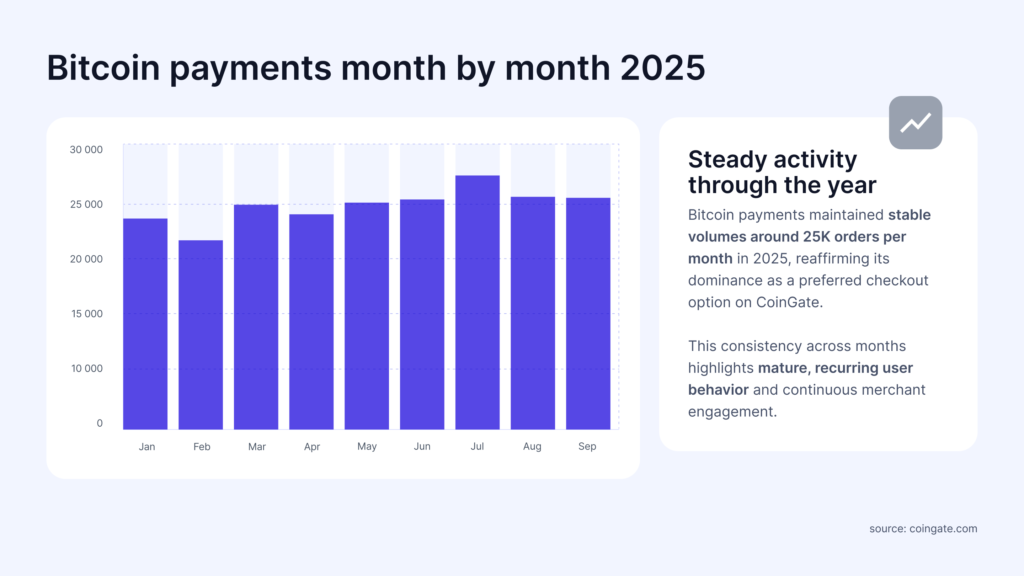
So far this year (Jan–Sep), Bitcoin accounts for 22.7% of all processed payments, placing it ahead of USDT (19.8%), LTC (14%), and USDC (11.5%). This resurgence underscores Bitcoin’s unique strength: when the market shifts, it doesn’t vanish – it reasserts itself.
The Lightning Network Effect
CoinGate integrated the Bitcoin Lightning Network in 2018, becoming one of the first global payment processors to do so. This early adoption marked a major milestone – it gave merchants access to instant, low-fee Bitcoin payments years before the broader market began to catch up.
Since then, Lightning has grown into an important part of the Bitcoin payments ecosystem. Between 2018 and 2025, 6% of all Bitcoin orders on CoinGate were processed through Lightning, showing steady but selective adoption among merchants and shoppers.
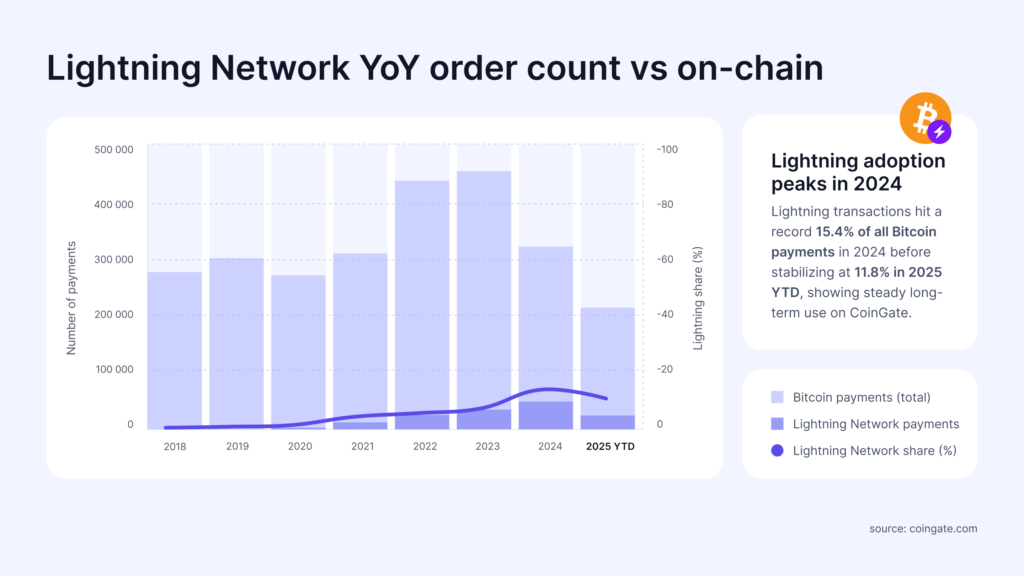
The peak year for Lightning usage was 2024, when 15.4% of all BTC orders were made through the Lightning Network. This surge reflected a wave of wallet integrations, higher network capacity, and broader awareness of Lightning’s advantages for microtransactions and fast checkouts.
In 2025, Lightning transactions make up 11.7% of all BTC orders – slightly lower than the year before but still representing a meaningful share of Bitcoin’s overall activity. This moderate decline suggests that while Lightning has proven its reliability, usage fluctuates with market trends, wallet adoption, and network capacity cycles.
Despite these variations, Lightning remains a crucial enabler of real-world Bitcoin payments. For merchants, it allows instant confirmations with minimal fees. For shoppers, it provides a smooth, low-cost experience even for small transactions – something traditional Bitcoin transactions can’t always match.
Together, these results reinforce a simple truth: Lightning is no longer an experiment. It’s an established layer of Bitcoin commerce that continues to expand its role year after year.
Who Pays with Bitcoin Today? Shopper Geography (2025 YTD)
Bitcoin continues to have the broadest global reach of any cryptocurrency used on CoinGate. From January to September 2025, shoppers paying with BTC came from over 150 countries, underscoring its role as a truly international payment method.
The United States remains the dominant market, responsible for 40.3% of all Bitcoin orders – by far the largest single share. In the North American region, Canada also accounts for a significant share of 4%.
Europe follows closely behind, led by Germany (6.3%), the United Kingdom (5.8%), and the Netherlands (5.2%), with additional strong participation from France (2.7%) and Switzerland (1.6%).
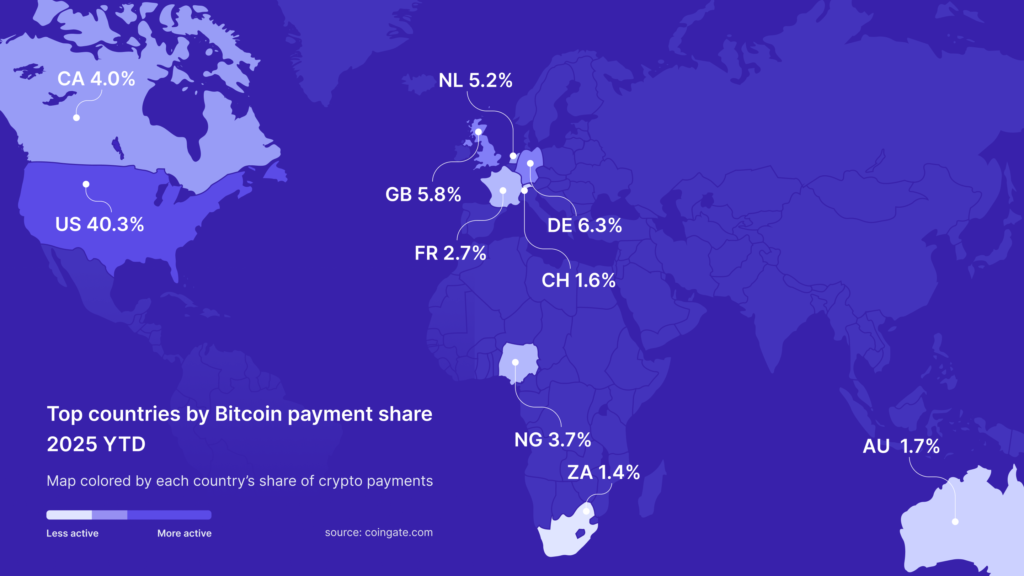
Beyond Europe and North America, adoption is strong in emerging markets. Nigeria (3.7%) stands out as the leading African market for Bitcoin payments, followed by South Africa (1.4%), reflecting a growing use of Bitcoin as a borderless and censorship-resistant means of payment. In the Asia-Pacific region, Australia (1.7%) continues to show consistent activity.
This distribution highlights Bitcoin’s dual appeal:
- In developed economies, Bitcoin serves as a convenient, trusted online payment option for digital goods and services.
- In emerging markets, it often acts as an accessible alternative to limited banking infrastructure and as a hedge against currency volatility.
Together, these regions paint a picture of Bitcoin as both a global currency for online commerce and a financial bridge where traditional systems fall short. If you’re interested in a broader geographical data, check out our breakdown of crypto usage by regions.
What Do People Buy with Bitcoin Today? Industries & Merchants (2025 YTD)
Bitcoin remains the most versatile currency on CoinGate, used across virtually every industry category on the platform. From high-value digital services to everyday consumer purchases, it continues to define what crypto commerce looks like in practice.
Industry Breakdown
In 2025 (Jan–Sep), Bitcoin payments are most common in web hosting, accounting for 35.3% of all BTC orders. This reflects a longstanding trend – hosting and domain service providers were among the earliest merchants to accept Bitcoin and remain some of its most loyal users.
Beyond hosting, Bitcoin drives payments in:
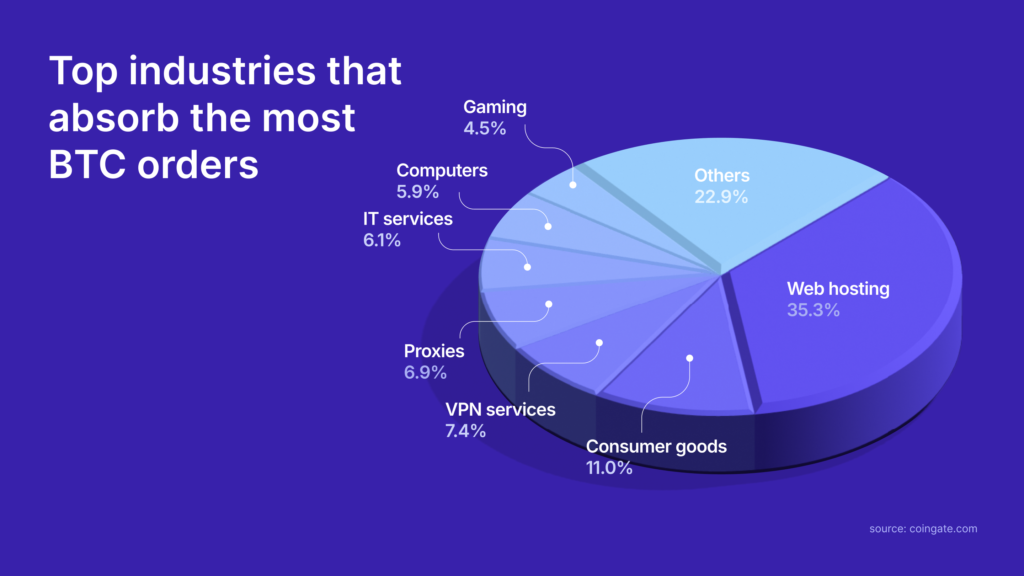
- Consumer goods & services (11%) – covering everything from electronics and digital subscriptions to virtual phone numbers and gift cards.
- VPNs (7.4%) – driven by privacy-conscious users who prefer paying with crypto.
- Proxies (6.9%) and IT services (6.1%), where Bitcoin’s global reach supports businesses serving international clients.
- Computers & tech (5.9%) and gaming (4.5%), representing the retail and entertainment side of crypto commerce.
- Other categories (22.9%), showing how deeply Bitcoin has penetrated general online commerce.
Leading Merchants
Among merchants, a few names stand out for their Bitcoin volume in 2025:
- Hostinger (15%) – leading the list with its global web hosting platform.
- NordVPN (5.1%) – reflecting strong crypto adoption in the privacy and security sector.
- Eldorado.gg (3.4%) – showing Bitcoin’s steady presence in the gaming and digital asset space.
These brands represent diverse but complementary industries that together highlight Bitcoin’s wide appeal – not just among crypto enthusiasts, but among everyday customers looking for fast, borderless, and trusted payment options.
Broader Insights
Unlike some altcoins that dominate specific niches, Bitcoin’s payment usage is broad and evenly distributed. It remains the default checkout option for most merchants that support multiple cryptocurrencies, often generating the majority of their crypto payment volume.
Cart Sizes & Payment Behavior
Bitcoin payments on CoinGate continue to represent some of the largest transaction values across all cryptocurrencies. In 2025, the average Bitcoin cart size stands at €132, 53.4% higher than the average cart size paid with other cryptocurrencies.
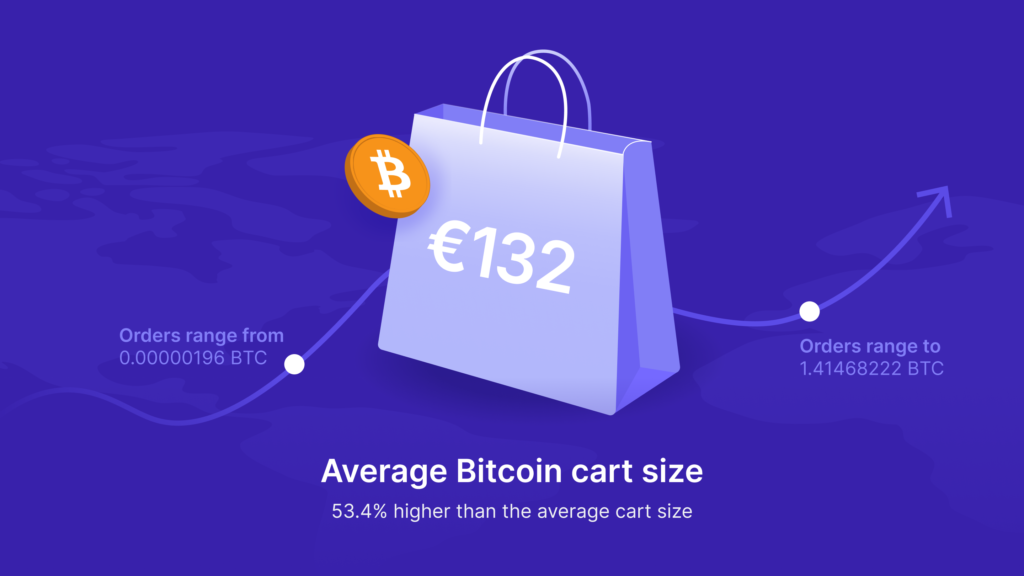
This figure captures Bitcoin’s position as the go-to currency for higher-value purchases – from premium hosting services and long-term subscriptions to high-end products and travel experiences.
Bitcoin also shows the widest order range among all payment methods. The smallest transaction recorded in 2025 was just 0.00000196 BTC (€0.18) for proxy services, while the largest reached 1.41468222 BTC (€100,000) for private jet services in April. This extreme spread highlights how Bitcoin serves both microtransactions and luxury purchases with equal reliability.
Such diversity in payment size reflects the maturity of Bitcoin users. Many treat BTC not as an experiment, but as a stable, convenient, and globally recognized payment rail. Whether for a €1 service or a €100,000 invoice, Bitcoin remains the trusted default for merchants and shoppers who want to move value efficiently across borders.
Payouts (SEND) in Bitcoin (2025)
Bitcoin remains a core part of CoinGate’s Crypto Payouts infrastructure, serving both as a destination currency and a conversion bridge between crypto and fiat. While stablecoins dominate total payout volume, BTC continues to play a critical supporting role – particularly for cross-border settlements and long-term treasury use.
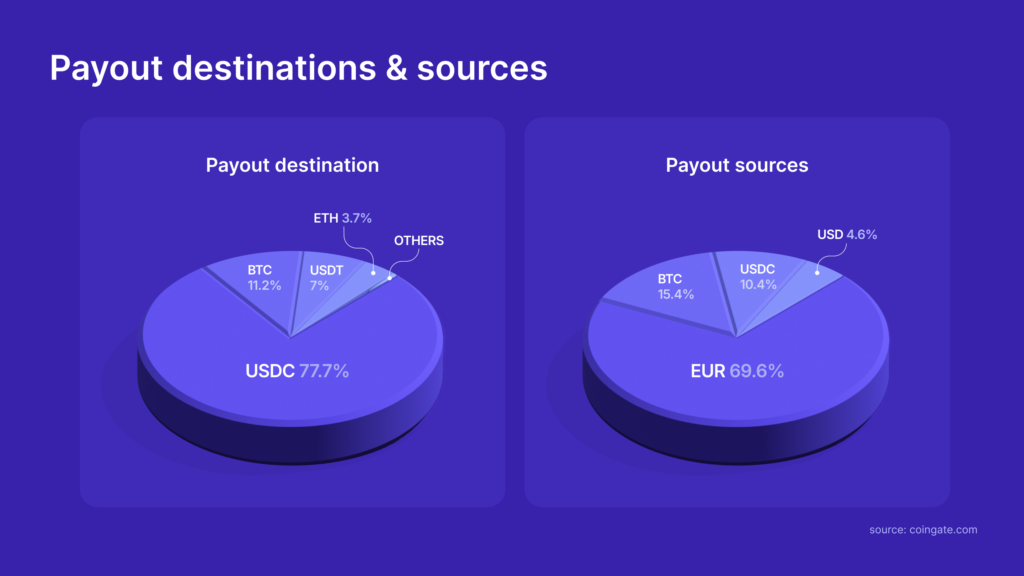
Payout Destinations
When merchants initiate payouts through CoinGate, the most common target currency in 2025 is USDC, which accounts for 77.7% of all payouts. Bitcoin itself remains the second most used option at 11.2%, followed by USDT (7%) and ETH (3.7%).
This shows that while most businesses prefer stablecoins for predictable value, Bitcoin still stands out as a trusted settlement asset, especially for companies already holding BTC balances or operating in crypto-native industries.
Payout Sources
On the other side of the flow, payouts funded in EUR (69.6%) dominate, followed by BTC (15.4%), USDC (10.4%), and USD (4.6%). This mix indicates that Bitcoin often serves as an intermediary asset, bridging traditional currencies and stablecoins through CoinGate’s conversion and FX tools.
Together, these figures highlight Bitcoin’s versatility: it’s not only a payment method but also a settlement bridge used by businesses to route and diversify value efficiently across different currencies.
Merchant Settlements in Bitcoin (2022–2025)
Bitcoin continues to be the most retained cryptocurrency on CoinGate, reflecting strong merchant confidence in its long-term value. Between 2022 and 2025, settlement behavior shows a clear shift: fewer businesses immediately convert Bitcoin to fiat, and more choose to keep it on their balance sheets.
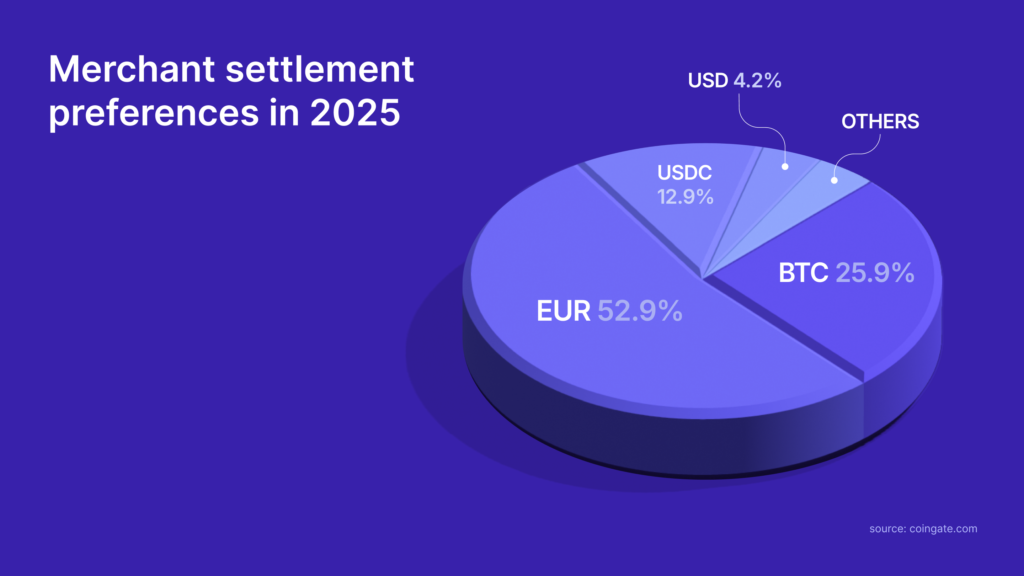
In 2025, 25.9% of BTC payments were kept in the original currency, the highest share recorded during this four-year period. The rest were converted primarily to EUR (52.9%), followed by USDC (12.9%) and USD (4.2%).
This marks a notable change from 2022, when 70.3% of all Bitcoin payments were converted to EUR, and only a small fraction were kept as BTC. Over time, the share of EUR settlements has steadily declined while USD and stablecoin conversions have grown – a sign that merchants are diversifying their settlement strategies and becoming more comfortable holding crypto assets.
The upward trend in BTC retention highlights a shift in perception. Bitcoin is no longer treated solely as a medium of exchange; for many businesses, it has become a dual-purpose asset – useful for daily transactions and valuable as a long-term treasury component.
Summary
Eleven years after becoming CoinGate’s first supported currency, Bitcoin remains the foundation of crypto payments. The data from 2014–2025 shows a story of endurance, adaptability, and leadership that few digital assets can match.
Despite the entrance of hundreds of new coins and the rapid rise of stablecoins, Bitcoin continues to dominate merchant payments, accounting for 44% of all processed transactions on CoinGate over the past decade. Its long-term consistency shows that while payment preferences evolve, trust in Bitcoin as a payment currency remains unmatched.
Several patterns stand out clearly:
- Bitcoin adapts to every market cycle. Even during the 2022 bear market, BTC payment volume grew by 41.7%, proving that real-world utility continues regardless of price movements.
- Stablecoins may rise – but Bitcoin reclaims. When USDT briefly overtook BTC in 2024, Bitcoin regained its #1 position in 2025 as regulations shifted and users returned to the most recognized crypto brand.
- Merchants are holding more BTC than ever. In 2025, 25.9% of BTC payments were kept on merchant balance sheets, the highest level since 2022 – signaling growing confidence in Bitcoin as a long-term store of value.
- The Lightning Network is solidifying its role. Lightning transactions represent 6% of all BTC payments since 2018, peaking at 15.4% in 2024, enabling fast, low-cost global payments that make Bitcoin more practical for everyday commerce.
- Bitcoin’s global reach is unmatched. With shoppers from more than 150 countries – led by the United States, Germany, and the United Kingdom – Bitcoin has evolved into a universal payment rail that connects markets, merchants, and customers across continents.
For businesses, the takeaway is simple: Bitcoin is not just the first crypto payment option – it’s still the most trusted and the most used. Its payment share may fluctuate with market cycles, but its relevance never fades. Whether as a transactional currency, a treasury asset, or a bridge for payouts, Bitcoin remains at the center of the crypto payments economy.
Accept crypto with CoinGate
Accept crypto with confidence using everything you need in one platform.

